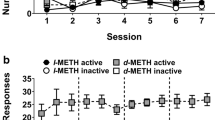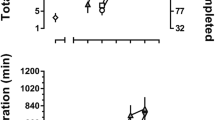Abstract
Methadone usually is taken orally for drug abuse treatment in humans but oral methadone self-administration by laboratory animals has not been investigated extensively. The present study examines acquisition and maintenance of oral methadone maintained responding in four adult male rhesus monkeys. Drug solution was available from one liquid delivery system and water from a second system during daily 3-h sessions. Locations of liquids were reversed each session, and liquid (0.65 ml per delivery) was delivered according to a fixed-ratio reinforcement schedule. Initially a test for the reinforcing effects of 0.00625–0.4 mg/ml methadone solutions was carried out but a consistent preference for drug over water was not seen. To establish methadone as a reinforcer, a fading procedure was used in which responding was first maintained by solutions of methadone (0.00625–0.4 mg/ml) combined with ethanol (0.0325–2.0% w/v). Subsequently, the concentration of the ethanol in the combination was gradually reduced to zero. Methadone-maintained responding (0.4 mg/ml) persisted when ethanol was no longer present. To confirm that the drug was serving as a reinforcer, the dose was varied: (a) by changing the volume delivered while the concentration was held constant and (b) by changing the concentration of the methadone while the volume per delivery was held constant. Over a wide range of doses, deliveries of methadone solution usually exceeded deliveries of concurrently available water. Orderly relationships were observed among methadone dose, response rate, and drug intake. The study of oral self-administration of opioid drugs by nonhuman primates may be a useful strategy for the development and evaluation of new drug substitution or replacement therapies.
Similar content being viewed by others
References
Altshuler HL (1978) The use of self-administration for assessing the action of the opiates. In: Adler ML, Manara L, Samanin R (eds) Factors affecting the action of narcotics. Raven Press New York, pp 173–192
Altshuler H, Weaver S, Phillips P (1975) Intragastric self-administration of psychoactive drugs by the rhesus monkey. Life Sci 17:883–890
Carroll ME, Meisch RA (1984) Enhanced drug-reinforced behavior due to food deprivation. In: Thompson T, Dews PB, Barrett JE (eds) Advances in behavioral pharmacology (vol. 4). Academic Press, New York, pp 47–88
Chipkin RE, Rosecrans JA (1978) Aversiveness of oral methadone in rats. Psychopharmacology 57:303–310
Claghorn JE, Ordy JM, Nagy A (1965) Spontaneous opiate addiction in rhesus monkeys. Science 149:440–441
Collins RJ, Weeks JR (1965) Relative potency of codeine, methadone and dihydromorphine to morphine in self-maintained addict rats. Naunyn-Schmiedeberg's Arch Exp Pathol 249:509–514
Committee on Care and Use of Laboratory Animal Resources, Commission on Life Sciences National Research Council (1985) Guide for the care and use of laboratory animals. US Department of Health and Human Services, Public Health Service, National Institutes of Health. NIH Publication NO. 25–83, US Government Printing Office Washington DC
Crowley TJ, Hydinger M, Stynes AJ, Feiger A (1975) Monkey motor stimulation and altered social behavior during chonic methadone administration. Psychopharmacologia 43:135–144
Deneau G, Yanagita T, Seevers MH (1969) Self-administration of psychoactive substances by the monkey. Psychopharmacologia 16:30–48
Dole VP, Nyswander ME (1965) A medical treatment for diacetylmorphine (heroin) addiction: a medication trial with methadone hydrochloride. JAMA 193:80–84
Downs DA, Miller LE, Wiley JN, Johnston DE (1980) Oral vs parental drug effects on schedule-controlled behavior in rhesus monkeys. Life Sci 26:1163–1168
Fields L, Bruno V, Keller K (1976) The stages of acquisition in stimulus fading. J Exp Anal Behav 26:295–300
Gieske D (1978) Integrated drinking device for monkeys. Reports from the Research Laboratories of the Department of Psychiatry, University of Minnesota, PR-78-1
Harrigan SE, Downs DA (1978) Self-administration of heroin, acetylmethadol, morphine, and methadone in rhesus monkeys. Life Sci 22:619–624
Henningfield JE, Meisch RA (1976) Drinking device for rhesus monkeys. Pharmacol Biochem Behav 4:609–610
Hubbard RL, Marsden ME, Rachel JV, Harwood HJ, Cavanaugh ER, Ginzburg HM (1989) Drug abuse treatment: a national study of effectiveness. University of North Carolina Press, Chapel Hill, N.C.
Kreek MJ (1992) Rationale for maintenance pharmacotherapy of opiate dependence. In: O'Brien CP, Jaffe JH (eds) Addictive states. Raven Press, New York, pp 205–230
Lemaire GA, Meisch RA (1984) Pentobarbital self-administration in rhesus monkeys: drug concentration and fixed-ratio size interactions. J Exp Anal Behav 42:37–49
Lynch MR, Porter JH, Rosecrans JA (1984) Latent inhibition in the aversion to oral methadone. Pharmacol Biochem Behav 20:467–472
Macenski M, Meisch RA (1992) Ethanol-reinforced responding of naive rhesus monkeys: acquisition without induction procedures. Alcohol 9:547–554
Meisch RA (1995) Oral self-administration of etonitazene in rhesus monkeys: use of a fading procedure to establish etonitazene as a reinforcer. Pharmacol Biochem Behav 50:571–580
Meisch RA, Lemaire GA (1988) Oral self-administration of pentobarbital by rhesus monkeys: relative reinforcing effects under concurrent fixed-ratio schedules. J Exp Anal Behav 50:75–86
Meisch RA, Lemaire GA (1989) Oral self-administration of pentobarbital by rhesus monkeys: maintenance of behavior by different concurrently available volumes of drug solution. J Exp Anal Behav 52:111–126
Meisch RA, Lemaire GA (1993) Drug self-administration. In: Van Haaren F (ed) Methods in behavioral pharmacology. Elsevier, New York, pp 257–300
Meisch RA, Kliner DJ, Henningfield JE (1981) Pentobarbital drinking by rhesus monkeys: establishment and maintenance of pentobarbital-reinforced behavior. J Pharmacol Exp Ther 217:114–120
Meisch RA, Bell SM, Lemaire GA (1993) Orally self-administered cocaine in rhesus monkeys: transition from negative or neutral behavioral effects to positive reinforcing effects. Drug Alcohol Depend 32:143–158
Mello NK, Lukas SE, Bree MP, Mendelson JH (1988) Progressive ratio performance maintained by buprenorphine, heroin, and methadone in macaque monkeys. Drug Alcohol Depend 21:81–97
McMillan DE, Leander JD, Wilson TW, Wallace SC, Fix T, Redding S, Turk RT (1976) Oral injestion of narcotic analgesics by rats. J Pharmacol Exp Ther 196:269–279
Moreton JE, Roehs T, Khazan N (1976) Drug self-administration and sleep-awake activity in rats dependent on morphine, methadone, or 1-alpha-acetylmethadol. Psychopharmacology 47:237–241
Samson HH (1986) Initiation of ethanol reinforcement using a sucrose substitution procedure in food- and water-sated rats. Alcohol Clin Exp Res 10:436–442
Schuster CR, Balster RL (1973) Self-administration of agonists. In: Kosterlitz HW, Collier HOJ, Villarreal JE (eds) Agonist and antagonist actions of narcotic analgesic drugs. University Park Press, New York, pp 243–254
Schuster CR, Smith BB, Jaffe JH (1971) Drug abuse in heroin users. Arch Gen Psychiatry 24:359–362
Snyder EW, Dustman RE, Straigt RC, Wayne AW, Beck EC (1977) Sudden toxicity of methadone in monkeys: behavioral and electrophysiological evidence. Pharmacol Biochem Behav 6:87–92
Spiga R, Grabowski J, Silverman PB, Meisch RA (1995) Human methadone self-administration: effects of dose and ratio requirement. Behav Pharmacol (in press)
Stewart RB, Lemaire GA, Roache JD, Meisch RA (1994) Establishing benzodiazepines as oral reinforcers: midazolam and diazepam self-administration in rhesus monkeys. J Pharmacol Exp Ther 271:200–211
Stitzer M, Bigelow G, Liebson I (1979) Supplementary methadone self-administration among methadone maintenance clients. Addict Behav 4:61–66
Stitzer ML, McCaul ME, Bigelow GE, Liebson IA (1983) Oral methadone self-administration: effects of dose and alternative reinforcers. Clin Pharmacol Ther 34:29–35
Tolliver GA, Sadeghi KG, Samson HH (1988) Ethanol preference following the sucrose-fading initiation procedure. Alcohol 5:9–13
Werner TE, Smith SG, Davis WM (1976) A dose-response comparison between methadone and morphine self-administration. Psychopharmacology 74:209–211
Young AM, Swain HH, Woods JH (1981) Comparison of opioid agonists in maintaining responding and in suppressing morphine withdrawal in rhesus monkeys. Psychopharmacology 74:329–335
Author information
Authors and Affiliations
Rights and permissions
About this article
Cite this article
Stewart, R.B., Grabowski, J., Wang, N.S. et al. Orally delivered methadone as a reinforcer in rhesus monkeys. Psychopharmacology 123, 111–118 (1996). https://doi.org/10.1007/BF02246167
Received:
Revised:
Issue Date:
DOI: https://doi.org/10.1007/BF02246167




